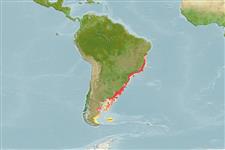Common names from other countries
>
Pleuronectiformes (Flatfishes) >
Paralichthyidae (Large-tooth flounders)
Etymology: Paralichthys: Greek, para = the side of + Greek, ichthys = fish + Greek, suffix, oides = similar to (Ref. 45335).
Environment: milieu / climate zone / depth range / distribution range
นิเวศวิทยา
เกี่ยวกับทะเล,น้ำเค็ม; กร่อย สัตว์น้ำหน้าดิน; ระดับความลึก 0 - 40 m (Ref. 26375). Subtropical; 12°S - 54°S
Southwest Atlantic: Brazil. Does not occur in Argentina nor in Uruguay (Ref. 43588).
ขนาด / น้ำหนัก / Age
Maturity: Lm ? range ? - ? cm
Max length : 100.0 cm TL เพศผู้/กระเทย; (Ref. 26375); common length : 40.0 cm TL เพศผู้/กระเทย; (Ref. 6077); น้ำหนักสูงสุดที่มีการรายงาน: 12.0 kg (Ref. 26375)
เงี่ยงครีบหลัง (รวม) : 0; ก้านครีบอ่อนที่หาง (รวม) : 68 - 86; เงี่ยงครีบก้น: 0; ก้านครีบอ่อนที่ก้น: 52 - 67. Pectoral fins small, about two times head on ocular side, 2.7-3.0 time head on blind side. Pelvic fins about equal in size and shape on both sides. Caudal fin double truncate (Ref. 27363).
Inhabits coastal areas, in bays and estuaries (Ref. 36453). Found over sandy or muddy substrate. Apparently, reproduction occurs during summer in small groups of 3-15 individuals. Adults are solitary. This species is very much appreciated for its taste and high commercial value.
Life cycle and mating behavior
Maturities | การสืบพันธุ์ | Spawnings | Egg(s) | Fecundities | ตัวอ่อน
Distinct pairing (Ref. 205).
Cervigón, F. and W. Fischer, 1979. INFOPESCA. Catálogo de especies marinas de interes economico actual o potencial para América Latina. Parte 1. Atlántico centro y suroccidental. FAO/UNDP, SIC/79/1. 372 p. FAO, Rome. (Ref. 6077)
IUCN Red List Status (Ref. 130435)
CITES (Ref. 128078)
Not Evaluated
Threat to humans
Harmless
Human uses
การประมง: การค้า; การตกปลาเป็นกีฬา: ใช่
เครื่องมือ
Special reports
Download XML
แหล่งที่มาจากอินเตอร์เน็ต
Estimates based on models
Preferred temperature (Ref.
115969): 11.7 - 26.1, mean 16.1 (based on 150 cells).
Phylogenetic diversity index (Ref.
82804): PD
50 = 0.5000 [Uniqueness, from 0.5 = low to 2.0 = high].
Bayesian length-weight: a=0.00646 (0.00384 - 0.01085), b=3.16 (3.02 - 3.30), in cm Total Length, based on LWR estimates for this species & Genus-body shape (Ref.
93245).
ระดับชั้นอาหาร (Ref.
69278): 4.4 ±0.6 se; based on size and trophs of closest relatives
ความสามารถในการกลับคืนสู่ปกติ (Ref.
120179): ขนาดกลาง, เวลาต่ำสุดที่จะทำให้ประชากรเพิ่มขึ้นเป็น 2 เท่าใช้เวลา 1.4 - 4.4 ปี (Preliminary K or Fecundity.).
Fishing Vulnerability (Ref.
59153): High vulnerability (60 of 100).
